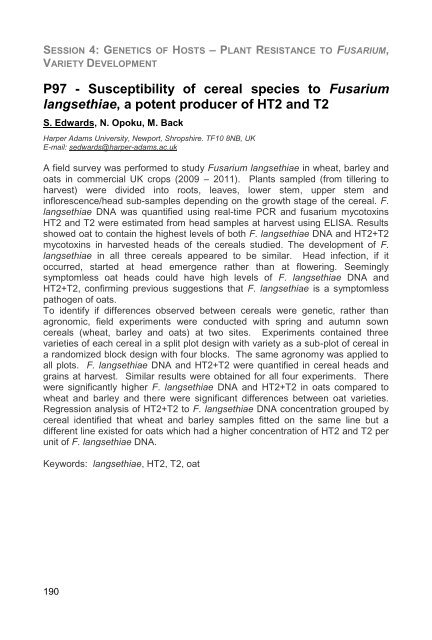EFS12- Book of abstracts - Contact
EFS12- Book of abstracts - Contact
EFS12- Book of abstracts - Contact
You also want an ePaper? Increase the reach of your titles
YUMPU automatically turns print PDFs into web optimized ePapers that Google loves.
SESSION 4: GENETICS OF HOSTS – PLANT RESISTANCE TO FUSARIUM,<br />
VARIETY DEVELOPMENT<br />
P97 - Susceptibility <strong>of</strong> cereal species to Fusarium<br />
langsethiae, a potent producer <strong>of</strong> HT2 and T2<br />
S. Edwards, N. Opoku, M. Back<br />
Harper Adams University, Newport, Shropshire. TF10 8NB, UK<br />
E-mail: sedwards@harper-adams.ac.uk<br />
A field survey was performed to study Fusarium langsethiae in wheat, barley and<br />
oats in commercial UK crops (2009 – 2011). Plants sampled (from tillering to<br />
harvest) were divided into roots, leaves, lower stem, upper stem and<br />
inflorescence/head sub-samples depending on the growth stage <strong>of</strong> the cereal. F.<br />
langsethiae DNA was quantified using real-time PCR and fusarium mycotoxins<br />
HT2 and T2 were estimated from head samples at harvest using ELISA. Results<br />
showed oat to contain the highest levels <strong>of</strong> both F. langsethiae DNA and HT2+T2<br />
mycotoxins in harvested heads <strong>of</strong> the cereals studied. The development <strong>of</strong> F.<br />
langsethiae in all three cereals appeared to be similar. Head infection, if it<br />
occurred, started at head emergence rather than at flowering. Seemingly<br />
symptomless oat heads could have high levels <strong>of</strong> F. langsethiae DNA and<br />
HT2+T2, confirming previous suggestions that F. langsethiae is a symptomless<br />
pathogen <strong>of</strong> oats.<br />
To identify if differences observed between cereals were genetic, rather than<br />
agronomic, field experiments were conducted with spring and autumn sown<br />
cereals (wheat, barley and oats) at two sites. Experiments contained three<br />
varieties <strong>of</strong> each cereal in a split plot design with variety as a sub-plot <strong>of</strong> cereal in<br />
a randomized block design with four blocks. The same agronomy was applied to<br />
all plots. F. langsethiae DNA and HT2+T2 were quantified in cereal heads and<br />
grains at harvest. Similar results were obtained for all four experiments. There<br />
were significantly higher F. langsethiae DNA and HT2+T2 in oats compared to<br />
wheat and barley and there were significant differences between oat varieties.<br />
Regression analysis <strong>of</strong> HT2+T2 to F. langsethiae DNA concentration grouped by<br />
cereal identified that wheat and barley samples fitted on the same line but a<br />
different line existed for oats which had a higher concentration <strong>of</strong> HT2 and T2 per<br />
unit <strong>of</strong> F. langsethiae DNA.<br />
Keywords: langsethiae, HT2, T2, oat<br />
190
















![Présentation CRB-anim [Mode de compatibilité] - Inra](https://img.yumpu.com/17418636/1/190x135/presentation-crb-anim-mode-de-compatibilite-inra.jpg?quality=85)